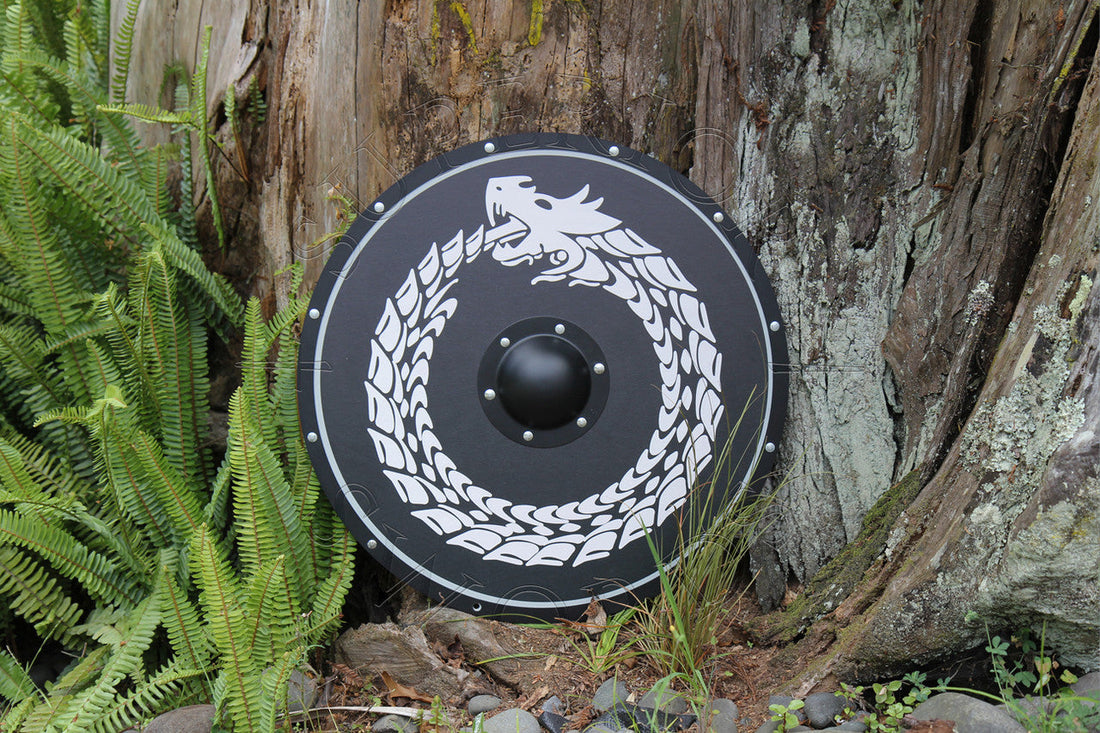
The Evolution of Viking Shields: A Journey Through Time
Share
Viking shields are more than just battle tools. They’re a symbol of power, craftsmanship, and history. These iconic shields have evolved over time, becoming a crucial part of Viking warfare and culture. Let’s take a look at how Viking shields transformed from simple wood planks to masterpieces that carry deep meaning for both warriors and historians alike.
Early Viking Shields: Simple Yet Effective
Viking shields first appeared around the 8th century. At this point, Viking shield designs were straightforward and practical. The shields were round and typically about 30 inches in diameter, made from wood and reinforced with a central steel boss. This iron center helped deflect blows and gave the shield more durability in battle.

The Vikings weren’t just interested in protecting themselves—they wanted to show off their skills and craftsmanship. Many shields had simple yet bold designs, featuring geometric patterns, runes, or other symbols that represented strength and protection. These early Viking shields were also lightweight, making them easy to maneuver in combat.
The Rise of Decorative Viking Shield Designs
By the 9th century, Viking shields were evolving into more than just functional items. The Vikings loved to express their identity through their weapons, and shields were no exception. As time passed, Viking shield designs became more intricate, with bold colors and detailed carvings.
Many Viking shields featured symbols tied to Norse mythology—like Thor’s hammer or intricate knotwork—reflecting the warrior’s belief system. These symbols weren’t just for show. The Vikings believed these symbols provided spiritual protection in battle, as well as a sense of pride. Warriors often personalized their shields to represent their family or tribe, making each shield unique.
The Viking Shield in Action: Beyond Protection
While the decorative side of Viking shields was important, these shields were still designed to be used in combat. The famous “shield wall” was one of the most effective tactics used by Viking warriors. By locking their shields together, they created a nearly impenetrable line of defense that could withstand even the fiercest enemy attacks.
But Viking shields weren’t just defensive—they were also offensive weapons. Vikings used their shields in battle to bash, block, and strike enemies. The shield was as much a tool for control as it was a defense against blows. And despite their heavy appearance, these shields were light enough to be wielded with speed and precision.
From Viking to Medieval Shields: Changes in Design
By the time the Viking Age came to an end in the 11th century, the Viking shield had already undergone several changes. As the Vikings settled into new lands and the world around them shifted, so too did their approach to warfare. With the rise of mounted knights and the changing nature of combat, the design of shields also evolved.
While Viking shields remained popular in Scandinavia, Europe saw the introduction of new types of shields during the medieval period. These shields were often more angular and designed for different forms of battle, especially mounted warfare. The iconic round shield of the Viking warrior gave way to more pointed, kite-shaped medieval shields, which offered more protection for knights on horseback.
Viking Shields Today: A Lasting Legacy
Despite the passing of centuries, Viking shields continue to captivate modern audiences. Whether used in historical reenactments, as part of a collection, or as display pieces, Viking shields remain a powerful connection to the past. Today’s Viking shield designs often mirror those used by the Vikings, with replicas handcrafted using the same materials: wood, leather, and metal.
These shields, whether as a symbol of heritage or a tool for reenactment, remind us of the Vikings' legacy. Even as medieval shields began to evolve into more specialized designs, Viking shields left an indelible mark on warfare and craftsmanship that is still admired today.
Final Words
The Viking shield has come a long way since its simple beginnings. From the first wooden shields used by Viking warriors to the ornate designs that symbolized power and protection, these shields offer a glimpse into the past. The journey of the Viking shield is a testament to the Vikings’ skills, culture, and influence. Today, these shields stand as a reminder of the strength and craftsmanship of the Vikings, continuing to inspire and captivate us.
